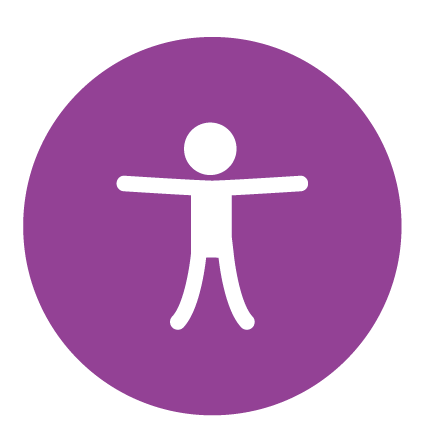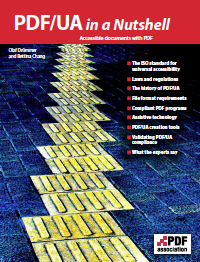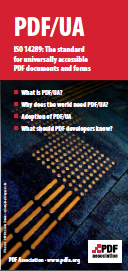
Accessible PDF
A fully PDF/UA compliant PDF can be just as
accessible as a WCAG compliant website.

Entirely barrier-free
Accessible PDF (PDF/UA) for Accessible eGovernment
Barrier-free PDF in accordance with the ISO Standard PDF/UA ensures
universal accessibility for everyone to digital information based on PDF technology;
such as barrier-free reading and editing of PDF documents and PDF forms
by
Olaf Drümmer
Founder, callas software, Germany,
Founder and Managing Director, axaio software, Germany,
PDF Association Lifetime Member
Adapted/Localized by
Kent Åberg
Founder and Managing Director, NewFormat AB, Sweden,
Liaison of PDF Association Scandinavia Chapter
(Join the callas software blog for PDF professionals!)
Making information easily accessible for all citizens
Making information easily accessible to citizens is undoubtedly a big part of
eGovernment and is sought after by federal and state authorities as well as
districts, cities and municipalities.
Increasingly, information is only offered and passed on in digital form,
whereby the reliable and user-friendly Portable Document Format (PDF)
has established itself worldwide as the preferred file format.
PDF is the format of choice for every kind of document used in all
industries, government and by all citizens.
PDF is trusted by everyone to reliably communicate accurate information.
All information that is worth saving and shared with others
is saved in the form of a PDF document.
Every year billions of PDF documents are created around the world.
Only within the Swedish public sector millions of PDF documents are created every year.
Since 2009, it is mandatory (according to the Swedish National Archives' regulations)
for Swedish government authorities to use the standard PDF/A-1 for long-term
electronic archiving of digital office documents and other digital documents.
To ensure unrestricted access to PDF-based information in every respect,
PDF files must meet certain requirements.
These are defined since 2012 in PDF/UA ("Universal Accessibility"),
the ISO Standard for "Accessible PDF Documents".
PDF/UA is a complementary, process-based standard applicable to
Swedish government authorities and bodies to make public documents
universally accessible for everyone.
A PDF document can simultaneously meet several standards,
for example both PDF/A and PDF/UA.
PDF/UA ensures that even citizens with greatly diminished vision,
insufficient command of written language or motor limitations
can capture and interactively use documents without outside help.
In addition, content from PDF/UA documents on mobile devices is
much easier for users to read than from a conventional PDF document;
added value for everyone.
A flattened curbside or stepless facilitates access for strollers,
wheelchair users, pedestrians, cyclists, transport,
emergency vehicles, and others. It is simply good for everyone!
The PDF/UA standard fulfills the corresponding function for removing
"digital barriers" when reading and editing documents and forms.
Without limiting the diversity of PDF technology, PDF/UA determines
how unrestricted accessibility of content in PDF files is ensured.
To this end, the PDF/UA standard defines requirements to exclude
barriers when accessing page content, form fields, notes, metadata
and other elements of PDF files.
This allows users who use special tools, such as screen readers,
special mouse or voice output and input, to interact with content
in PDF documents.
PDF/UA, in turn, offers the author clearly defined criteria that must be
observed when creating accessible documents.
In order to achieve the goal of accessibility, the PDF/UA standard requires,
among other things, the following:
- All content in the PDF file must be correctly tagged.
Headings, regular paragraphs, lists and tables must be marked as such.
- The levels of the headings must reflect the internal structure of the document.
- The intended reading sequence for the entire content must be clearly defined.
- A corresponding text must be assigned to pictorial representations and
graphical illustrations, which reflects the pictorial content in words.
- The language in which a text is written must be specified.
- Language changes within the text must also be indicated;
e.g. that a Swedish word is used in an otherwise English text.
- Information may not be represented solely by colour or contrast.
Most of these requirements are met by additional, invisible markers in
the PDF page descriptions, which are called "tags".
These tags provide PDF elements with additional information about
the content, position and type of the element, and integrate all elements
into a semantic overall structure.
This defines headings, captions and navigation elements.
Assistive Technology (AT) devices use the tags in a PDF/UA document
to reproduce the contents of the document.

Click on image
Example of a correctly tagged PDF document and its structure tags.
This is the basis for the practical use of accessible PDF despite barriers
such as blindness, significantly reduced vision or restrictions in mobility
that necessitate the use of technical aids.
Screen readers are dependent on all content being in text form,
which can then be read aloud via speech synthesisers or output
as Braille on a Braille display.
The use of special mouse, voice control and other tools for
effective navigation in and interaction with documents require access to
the content structure of the document in the form of the tag structure.
This is achieved by logically linking the tags, which means that all
content elements are also assigned to a semantic role.
These can then be connected in a logical read sequence,
regardless of the page and position on which they are placed.
These tags can also be defined later in existing PDFs using programs such as
Adobe Acrobat - but this is an extremely tedious and time-consuming task.
It is much more effective to perform corresponding preparatory work in creation
programs, such as Microsoft Word and PowerPoint, or OpenOffice and LibreOffice,
or Adobe InDesign for professional publications.
They already offer the possibility to create, to a certain degree,
a good quality tagged PDF directly from the application,
even if this does not yet achieve full PDF/UA quality in some points.
Note! To shorten the time-consuming task of tagging,
we do recommend the use of more specialized tools
in closing the remaining gap to PDF/UA conformity.
But how does an author check whether the documents created by him/her
really correspond to the specifications stored in PDF/UA?
Since 2013, "The Matterhorn Protocol", developed by the PDF Association,
in coordination with the ISO, has been available as a binding test catalogue
for barrier-free PDF documents and forms.
The Matterhorn Protocol consists of 31 test sections consisting of 136 individual,
precisely defined fault conditions.
This makes it easier for authors to create and verify
PDF/UA compliant PDF files and forms.
Each test section represents a specific area of conformity requirements,
such as "definition of text language" or "metadata".
The individual error conditions define a specific test at
document, page, object or JavaScript level.
Some of the error conditions can be programmatically checked by software,
for example with the free PDF Accessibility Checker (PAC).
PAC is considered the first tool based entirely on the Matterhorn protocol.
A number of other error conditions must be tested interactively,
for example "Headings are not marked as headings".
The free callas pdfGoHTML plug-in for Adobe Acrobat
from callas software supports this.
callas pdfGoHTML displays the document structure including
reading sequence, headings, text paragraphs, alternative texts for images,
and tables structures in an easy-to-understand quick diagnosis view
with coloured markings.
PDF documents that contain tables require special attention;
for example, consolidated annual reports for corporate groups
contain often lots of complex data tables.
These type of reports are often created with Adobe InDesign.
Admittedly, it is possible to afterwards remediate also complex
data tables in PDF documents so that they become digitally accessible,
preferably with the axesPDF software in cases where one does not have
access to the source file, but the preferred (easiest and fastest) way is to
tag these tables according to the requirements of the PDF/UA standard
in the source document at the time the document is first created.
axaio MadeToTag is the unique plugin for Adobe InDesign that you need
to much faster and easier create accessible PDF documents from within
Adobe InDesign (in your .indd source file) according to the PDF/UA standard.
A 7-step guide ensures that you do not miss out on any important action.
Another benefit of axaio MadeToTag for Adobe InDesign is that
no post-processing of the exported PDF document is required to
be performed with Adobe Acrobat, which in turn means many
saved working hours for you.
Accessibility does not only affect people with more or less severe disabilities.
A correctly tagged PDF with a clean tag structure is a big step towards
the optimal creation, editing, output and utilization of accessible
documents in general.
For example, and directly thanks to PDF/UA,
search engines can index accessible PDFs much better.
Structured PDF files can be used much better than conventional documents.
For format conversions, like PDF to HTML,
unformatted text or RTF, or Microsoft Word and OpenOffice Writer,
the conversion results become more reliable thanks to
well performed and correct tagging.
On mobile devices with a comparatively small display, content from
PDF/UA documents can be presented in a more user-friendly way.
This plays a particularly important role in a society shaped where
the citizens operate mobile devices on a daily basis for all kind of services,
and is also a clear opportunity for a successful eGovernment to be involved in.
See also:
|











